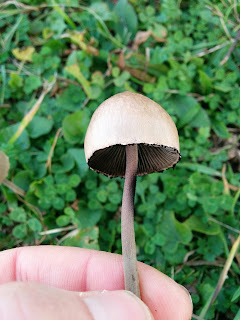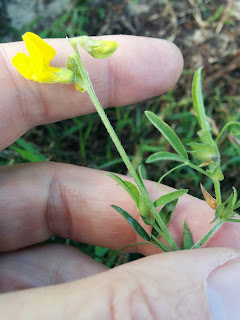Monday, November 30, 2015
Common Chameleon
Common Chameleon, Chamaeleo chamaeleon, (and to a far lesser degree the African Chameleon, Chamaeleo africanus) is found in many Mediterranean countries. This one was picked up (literally) in Morocco where they are associated with the devil and a great deal of folklore.
Friday, November 27, 2015
Butcher's Broom
I came across this growing at the base of a hedge bordering a driveway to some old cottages and the church at Compton Beauchamp. It's Butcher's Broom or Ruscus aculeatus. It is a peculiar plant. The 'leaves' are actually flattened modified stems (cladodes) in the middle of which the small whitish flowers appear. The red fruit look almost artificial in colour.
In many areas of the country it is an ancient woodland indicator. It used to be part of the Lily family but this has now been re-named the Asparagaceae family.
In many areas of the country it is an ancient woodland indicator. It used to be part of the Lily family but this has now been re-named the Asparagaceae family.
Thursday, November 26, 2015
Red Kite
 |
| "Red Kite - Gigrin Farm" by Tim Felce (Airwolfhound) - Red Kite - Gigrin Farm. Licensed under CC BY-SA 2.0 via Commons |
They remind me a little of Marsh Harriers with their striking wing markings and gliding habit of tail-twisting. In medieval times they kept the streets clean of carrion, helping to reduce the risk of water pollution and other sequelae of putrefaction.
Wednesday, November 25, 2015
Yellowhammer
 |
| "Emberiza citrinella -New Zealand" by Alan Vernon - originally posted to Flickr as Yellowhammer (Emberiza citrinella) in New Zealand, North Island. Licensed under CC BY 2.0 via Commons |
There were around twenty birds with half as many Chaffinch and a pair of Bullfinch. Certainly the largest flock I've seen to date. The intensity of the yellow male plumage is shocking when you first see it, making you think that this must be an escaped exotic such as a Canary.
They have a distinctive song which is usually rendered in the books as "a little bit of bread and chee-eese."
posted from Bloggeroid
Tuesday, November 24, 2015
Fieldfare
 |
| "Turdus pilaris" by Arnstein Rønning - Own work. Licensed under CC BY-SA 3.0 via Commons |
Monday, November 23, 2015
Common Duckweed
This grows in the ditches down on the reserve at Lewes Brooks. It's Common Duckweed, Lemna minor. There are other Lemnas...Greater, Rootless, Least, Fat and Ivy-leaved. So you don't have to settle on this one. But you do need to get up close to discern them. Minor has three veins but minuta (Least) only has one.
Sunday, November 22, 2015
Flowering Currant

I took this back in April. It's a garden escape because it isn't native here, originating from the western United States and Canada. It is Flowering Currant, Ribes sanguineum, and its attractive flowers and early flowering make it something of a horticultural favourite. It was introduced to this country in 1826 with the first record of a naturalised plant in 1916. Since that time it has spread and can be found from the Highlands to the south coast.
Saturday, November 21, 2015
Osprey
 |
| "2010-kabini-osprey" by Yathin S Krishnappa - Own work. Licensed under CC BY-SA 3.0 via Commons |
Ospreys are unusual in that they can reverse their outer toes, like owls, to allow it to grasp prey with two talons in front and two behind. They are also unusual in being a single species found across the globe, although subspecies are recognised in most taxonomies.
Friday, November 20, 2015
Barn Swallow
 |
| "Rauchschwalbe Hirundo rustica" by Andreas Trepte - Own work. Licensed under CC BY-SA 2.5 via Commons |
Thursday, November 19, 2015
White Stork
| "Ciconia ciconia - 01" by Carlos Delgado. Licensed under CC BY-SA 3.0 via Commons |
Common Bulbul
I am struggling to find a non-copyright photo of a Common Bulbul, Picnonotus barbatus, but there are some lovely images on this blog.
I too am in Morocco and this bird is a common visitor to the garden where we're staying. Its calls and song are loud and easily recognisable. The following recording was made in Oualidia where we are the guests of my old chum James (see Firecrest) at his remarkable villa overlooking the lagoon.
Tuesday, November 17, 2015
Buddleia
This is the third and final catch up species today: Buddleia or Butterfly Bush, Buddleja davidii. The irony is that although butterflies love it, it is often responsible for shading out the food plants of the caterpillars. It was introduced from China and is now an established invasive species. The French missionary and botanist, Jean Andre Soulie, who sent it back at the beginning of the twentieth century, was tortured and shot by Tibetan monks in 1905.
Great Willowherb

Growing in the garden, this is Great Willowherb, Epilobium hirsutum. It is, as the binomial suggests, very hairy. It has large flowers with a distinctive large creamy stigma with four lobes that arch backwards forming a cross.
Willowherbs are a family in their own right, but the family name is Onagraceae.
This is one of three posts needed to bring the blog up to speed, having been a bit slack at the end of October.
I have also noticed that I've blogged one species twice. A big money prize for anyone who spots which it is.
Burnet Rose
This is Burnet Rose, Rosa pimpinellifolia, growing in dunes at Llangennith at the end of Gower. There were no cream flowers at the end of August when this photo was taken, but the distinctive black globose fruit and red stems with red-tinged leaves are distinctive.
The Roses are one of the trickiest groups to identify accurately. There is a whole BSBI Handbook devoted to the matter by the inestimable Rev Dr Anthony Primavesi. They also hybridise, further complicating the issue.
Monday, November 16, 2015
Meadow Vetchling
Another August plant: Meadow Vetchling, Lathyrus pratensis. It's fairly common and is a scrambler rather than prostrate like Bird's-foot trefoil. The clue is in the tendrils, just visible in the photo on the right. It is a member of the Pea family, Fabaceae, and like all of them, fixes atmospheric nitrogen via bacteria-containing nodules in its roots.
Sunday, November 15, 2015
Bacon-and-eggs
Busy entertaining Beasley yesterday so didn't get to post (again). He'd come from Australia so it seemed reasonable to put the blog on hold (again).
This is another find in the annals: Common Bird's-foot-trefoil, Lotus corniculatus, also known as Bacon-and-Eggs. (cf. Common Toadflax).
There is also Narrow-leaved BFT and Greater BFT, but this is Common and also common. It is an important food plant for many butterflies, particularly the Blues.
Friday, November 13, 2015
Common Restharrow

Another plant from the times of excess. This is Common Restharrow, Ononis repens, growing on the land previously occupied by the huge coal-fired power station at Burry Port on the north shore of the Loughor Estuary across from Gower. It is common and also grows in the verges around the corner from our house.
Thursday, November 12, 2015
Horse Radish
Scraping the barrel a bit. It's definitely getting harder to find new species to snap given that my entomological skills are practically zero. So I've been trawling my photos for previously rejected material. This is one such: Horse-radish, Armoracia rusticana, growing on the site of a demolished power station on the north shore of the Loughor Estuary in South Wales at Burry Port. Its huge leaves are the distinctive feature, the flowers being rather dull white racemes of the typical crucifer sort.
It's the tap root that you want. Long and usually very thin. We have some in the garden which never flowers and invariably gets demolished by the slugs and snails. It was introduced from south east Europe.
It's the tap root that you want. Long and usually very thin. We have some in the garden which never flowers and invariably gets demolished by the slugs and snails. It was introduced from south east Europe.
Wednesday, November 11, 2015
Upright Hedge-Parsley

Who said Umbelliferas weren't interesting? I think Cow Parsley has given them a bad name, being so apparently common. Things will change when Rape usurps Cow Parsley in our hedgerows.
But this is Upright Hedge-Parsley, Torilis japonica, which takes over from Cow Parsley on the roadsides and hedges from July to early September. This one was growing in a protected spot at the base of a wall overrun with Vinca minor.
Monday, November 09, 2015
Egghead Mottlegill


This was growing in downland pasture back in October and is a member of the Panaeolus or Mottlegill family. It is Egghead Mottlegill, Panaeolus semiovatus and not the magic mushroom. The latter is not totally dissimilar but has a very obvious nipple at the crown of the cap. This one is common and grows on dung. It is not edible.
Sunday, November 08, 2015
Kestrel
 |
| "Common kestrel falco tinnunculus" by Andreas Trepte, www.photo-natur.de. Licensed under CC BY-SA 2.5 via Commons |
There is a nest box used annually on the side of the Nuffield Hospital in Woodingdean and I often see one of the adults hunting in the fields around the racecourse on my way to work.
Subscribe to:
Comments (Atom)




































